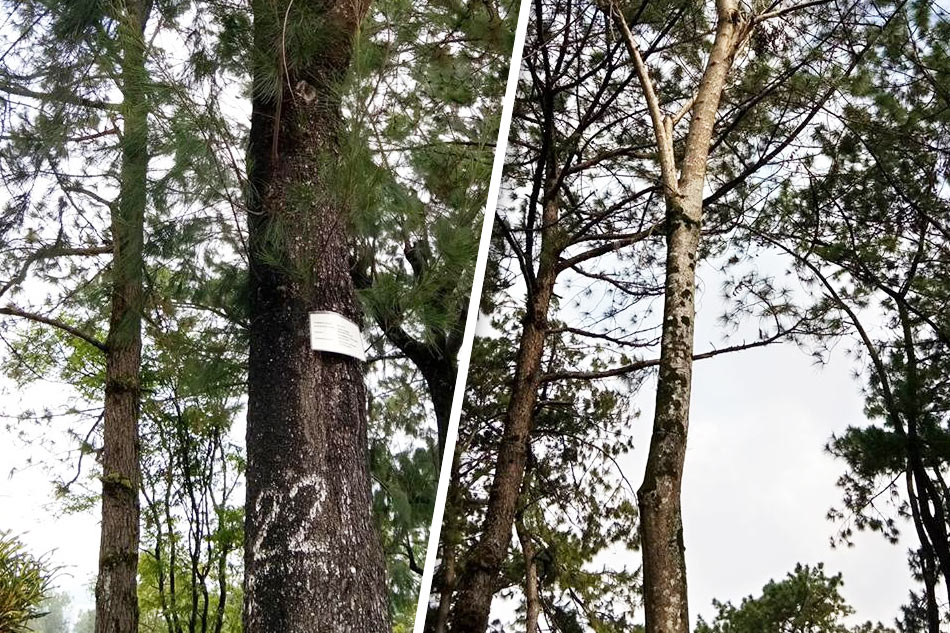2 tree species found to be detrimental to Baguio's pine trees | ABS-CBN
ADVERTISEMENT

Welcome, Kapamilya! We use cookies to improve your browsing experience. Continuing to use this site means you agree to our use of cookies. Tell me more!
2 tree species found to be detrimental to Baguio's pine trees
Melinda Ramo,
ABS-CBN News
Published Aug 16, 2017 10:53 PM PHT
BAGUIO CITY - The City Environment and Parks Management Office (CEPMO) said it discovered that 2 non-endemic trees here have had negative effects on local pine trees.
BAGUIO CITY - The City Environment and Parks Management Office (CEPMO) said it discovered that 2 non-endemic trees here have had negative effects on local pine trees.
According to Floro Bastian, an environment-management specialist, in a bid to withstand a beetle attack in Baguio three decades years ago, the government planted three non-endemic trees to prevent a monoculture of pine trees.
According to Floro Bastian, an environment-management specialist, in a bid to withstand a beetle attack in Baguio three decades years ago, the government planted three non-endemic trees to prevent a monoculture of pine trees.
These include African tulip, bottle brush, and agoho trees.
These include African tulip, bottle brush, and agoho trees.
"Pero ang nangyari, hindi pala effective. Nagkaroon ng outbreak ng beetles, kaya ibinalik ulit ang pine trees," Bastian said.
"Pero ang nangyari, hindi pala effective. Nagkaroon ng outbreak ng beetles, kaya ibinalik ulit ang pine trees," Bastian said.
ADVERTISEMENT
(But it turned out to be ineffective. There was an outbreak of beetles, that's why we brought back pine trees.)
(But it turned out to be ineffective. There was an outbreak of beetles, that's why we brought back pine trees.)
According to a recent study conducted by the CEPMO, agoho trees have wide leaf systems that may compete with pine trees for sunlight, while the wide root systems of African tulips compete for water and space.
According to a recent study conducted by the CEPMO, agoho trees have wide leaf systems that may compete with pine trees for sunlight, while the wide root systems of African tulips compete for water and space.
Bastian said his office now has measures in place to manage these trees.
Bastian said his office now has measures in place to manage these trees.
"Itong agoho trees natin very dominant siya, kailangang i-trim siya para lalabas ang mga pine trees. Kaya lang matrabaho kasi ang dami-dami nang agoho na considered weeds din siya," he said.
"Itong agoho trees natin very dominant siya, kailangang i-trim siya para lalabas ang mga pine trees. Kaya lang matrabaho kasi ang dami-dami nang agoho na considered weeds din siya," he said.
(Our agoho trees are very dominant. They have to be trimmed for the pine trees to appear. However, this requires work because there are a lot of agoho trees that they are also considered weeds.)
(Our agoho trees are very dominant. They have to be trimmed for the pine trees to appear. However, this requires work because there are a lot of agoho trees that they are also considered weeds.)
ADVERTISEMENT
"Itong African tulip naman, kailangang bawasan kasi very invasive siya. Malaking space ang kinakain kaya wala nang space ang mga pine tree," he added.
"Itong African tulip naman, kailangang bawasan kasi very invasive siya. Malaking space ang kinakain kaya wala nang space ang mga pine tree," he added.
(The African tulips have to be trimmed because it is very invasive. It eats up too much space so that there is no more space for the pine tree.)
(The African tulips have to be trimmed because it is very invasive. It eats up too much space so that there is no more space for the pine tree.)
Aside from managing the non-endemic trees, CEPMO also aims to plant 40,000 pine trees every year to strengthen Baguio's reputation as "The City of Pines."
Aside from managing the non-endemic trees, CEPMO also aims to plant 40,000 pine trees every year to strengthen Baguio's reputation as "The City of Pines."
ADVERTISEMENT
ADVERTISEMENT



